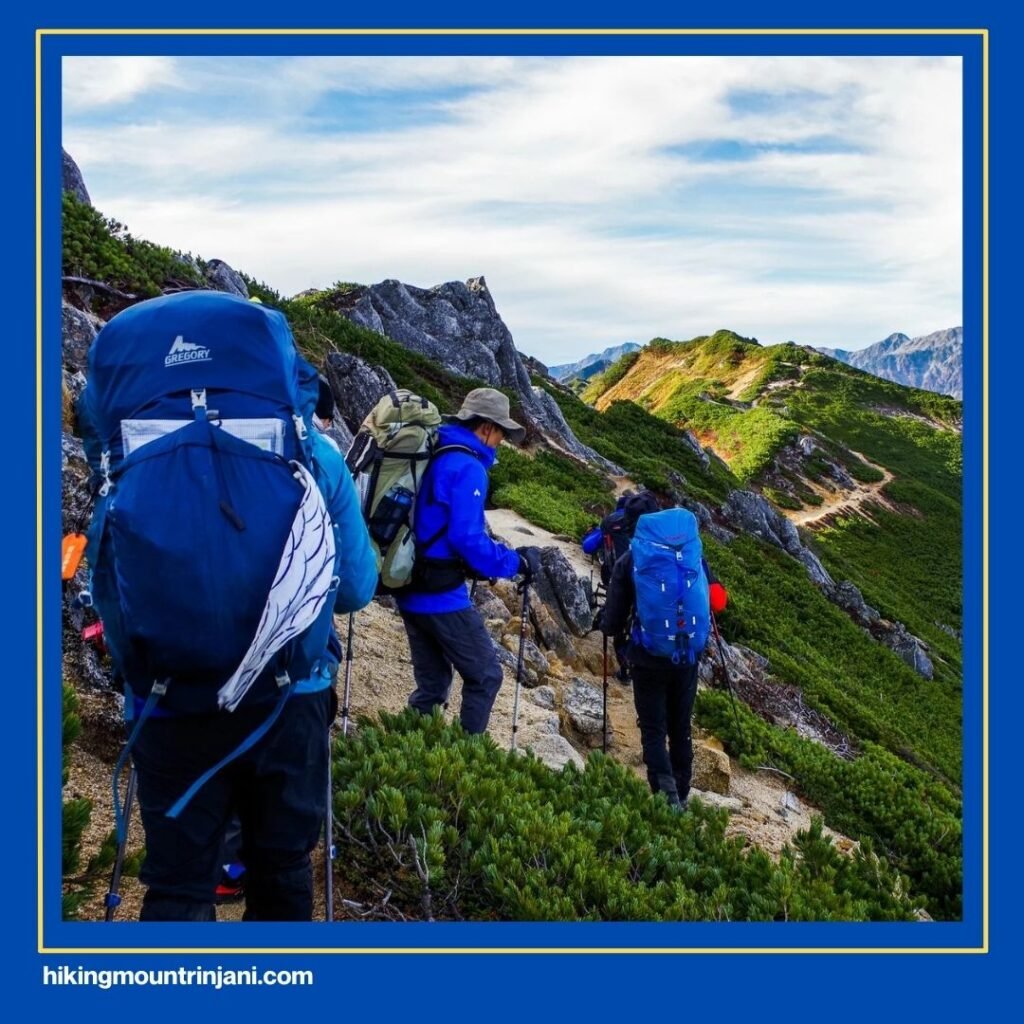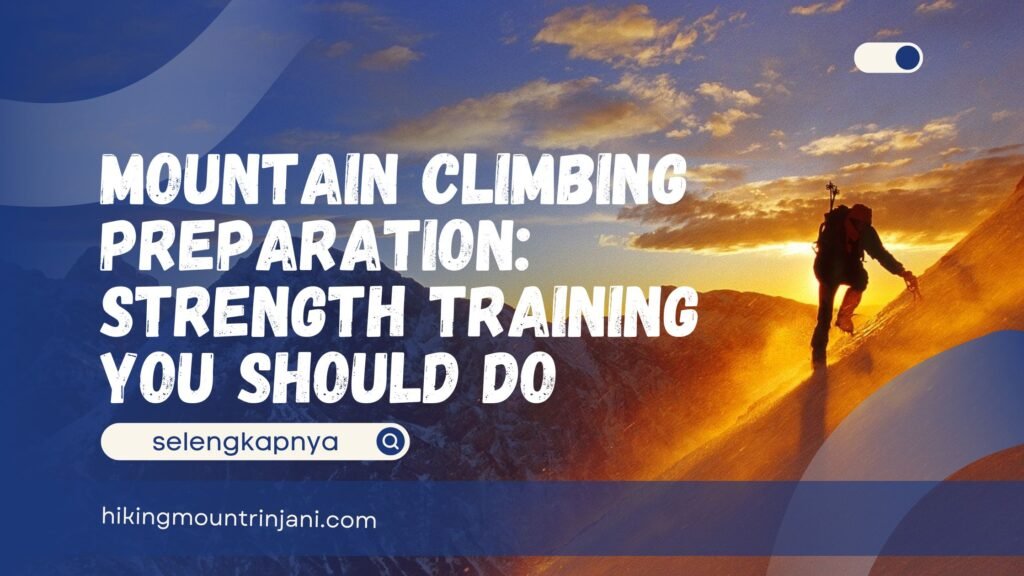Mountain Climbing Preparation – Climbing a mountain is never just about reaching the summit. It’s about preparing your body, mind, and spirit to endure hours, sometimes days—of challenging terrain, unpredictable weather, and thin air.
If you’ve set your eyes on Mount Rinjani in Indonesia, one of the most breathtaking yet demanding trekking destinations in Southeast Asia, then preparation is the key to success.
Too often, climbers underestimate the physical demand. They focus on gear and itineraries but forget that the real foundation of a safe and enjoyable climb is your fitness level. Without proper training, even the most determined hikers can struggle.
That’s why mountain climbing preparation should start months before your departure date, with the right exercises and training sequence to build up strength, stamina, and resilience.
This guide will walk you through the essential training needed, exercise routines to follow, and how to structure your workout according to your climbing schedule, whether you have just one month to prepare or a full three months to build strength. Let’s get started.
What Training Is Needed For Mountain Climbing?

When it comes to mountain climbing, you’re not just walking uphill, you’re carrying weight, pushing through steep ascents, and sometimes battling fatigue at high altitudes. That means your body needs more than just casual cardio. You need a well-rounded program that includes:
1. Cardiovascular Endurance
Long treks demand sustained energy. Jogging, cycling, or swimming are great ways to build your lung capacity and stamina. Aim for 30–45 minutes, 3–4 times a week.
2. Leg Strength for Mountain Climbing
Your legs do most of the work while climbing. Squats, lunges, step-ups, and stair climbing will strengthen your quads, hamstrings, calves, and glutes—making uphill battles less painful.
3. Core Stability for Mountain Climbing
A strong core helps maintain balance on uneven terrain while reducing the risk of back pain from carrying a backpack. Planks, Russian twists, and mountain climbers (the exercise) are excellent choices.
4. Upper Body Strength
While your legs drive you forward, your arms and shoulders support you when using trekking poles or scrambling over rocks. Push-ups, pull-ups, and rows can give you the upper body strength you’ll need.
5. Flexibility and Mobility
Stretching and yoga can keep your muscles supple and reduce the chance of injury during long hikes.
And, don’t forget about mental training. Don’t forget that mountain climbing is also about endurance of the mind. Long walks, practicing patience, and visualizing success help prepare you mentally for tough stretches.
In short, your mountain climbing preparation should combine strength, cardio, flexibility, and mental focus.
Read also: Is Mount Rinjani Worth It for Foreign Hikers? An Honest Review
Exercise Routine for Mountain Climbing Preparation

Now that you know what to train, the question is: in what order and how should you train to avoid overtraining and injury?
Here’s a safe and effective weekly exercise routine you can adapt:
Day 1: Strength Training (Legs & Core)
- Squats: 3 sets of 12 reps
- Do walking lunges by stepping forward and lowering your body, then switch legs. Repeat about three sets of ten per side. This move builds leg power for uphill climbs.
- Step-ups on a bench or stairs: 3 sets of 12 reps
- Plank holds: 3 × 45 seconds
Day 2: Cardio Endurance
- Jogging or brisk walking for 40 minutes
- If possible, choose hilly terrain or treadmill incline to simulate climbing
Day 3 is dedicated to rest and active recovery. Instead of pushing your body harder, give it the chance to heal and recharge.
This doesn’t mean lying in bed all day, light activities such as gentle yoga, stretching, or even a relaxed cycling session can help improve blood flow, reduce muscle soreness, and keep your body flexible for the tougher workouts ahead.
For Day 4: Strength Training (Upper Body & Core)
- Push-ups: 3 sets of 12 reps
- Practice pull-ups, or use assistance if needed. Aim for three sets of six to eight repetitions to strengthen your arms and back for climbing support.
- Dumbbell rows: 3 sets of 12 reps
- Russian twists: 3 × 20 reps
Day 5 & 6 : Mountain Climbing Preparation
- Strap on your backpack (start with 5–7 kg, then gradually increase)
- Walk or hike for 1–2 hours on mixed terrain
- Day 6: Cardio interval training. 20–30 minutes of HIIT (High-Intensity Interval Training) with cycling, running, or stair climbing
Day 7 is your full rest day. After a week of strength training, cardio, and long hikes, your muscles deserve time to repair and grow stronger. Use this day to relax, recharge, and let your body adapt to the demands you’ve placed on it, so you’ll be ready to push forward again next week.
The key is balance: give your body time to recover while gradually building intensity. Training like this ensures you won’t burn out before your actual climb.
Read also: Climbing Mount Rinjani in November, Is It Good? Let’s Find Out
How to Train According to Your Climbing Schedule

Of course, not everyone has the same preparation time. Some climbers book their trip months ahead, while others decide last-minute. So how should you train depending on your timeline?
1. If You Have 2–3 Months Before the Climb
This is the ideal scenario. With 8–12 weeks, you can progress steadily without overwhelming your body.
- Weeks 1–4: Focus on building a base—light cardio (3–4 times a week) and bodyweight strength training.
- Weeks 5–8: Increase intensity—add weight to your backpack during hikes, extend cardio sessions to 60 minutes, and start interval training.
- And weeks 9–12: Simulate real conditions—train on steep hills, increase pack weight to match your actual trekking load, and practice long hikes (4–6 hours once a week).
2. If You Have Only 1 Month Before the Climb
The timeline is tight, but not impossible. The goal here is to maximize endurance without injury.
- Weeks 1–2: Alternate strength training and cardio, 5–6 days a week. Keep rest days minimal but don’t skip recovery completely.
- For weeks 3–4: Prioritize long hikes and hill training. Twice a week, load your backpack with 7–10 kg and hike for 2–3 hours. Reduce heavy gym sessions—focus on endurance instead.
Whether you have one month or three, remember: consistency matters more than intensity. It’s better to train moderately and regularly than to push too hard and end up injured.
Want to Climb Mount Rinjani in Indonesia? Join Us!

Mount Rinjani is not just another hike, it’s an adventure through lush forests, volcanic landscapes, and finally to the summit at 3,726 meters, where the sunrise view is nothing short of magical. But as challenging as it is beautiful, this climb demands preparation and support.
That’s where we come in. At Hiking Mount Rinjani (hikingmountrinjani.com), we are a trusted trekking organizer with years of experience guiding international climbers. Our team doesn’t just take you up the mountain—we help you:
- Prepare beforehand,
- Ensuring you know what to bring,
- How to train,
- and how to succeed on the trail.
You don’t need to worry about tents, meals, or logistics. We provide everything with the highest quality, at prices that remain affordable. All you have to do is bring your determination, and maybe a few friends to share the journey with.
So, are you ready? If you’re dreaming of conquering Mount Rinjani, let’s make it happen together. Visit hikingmountrinjani.com today and start your journey with us.
|

